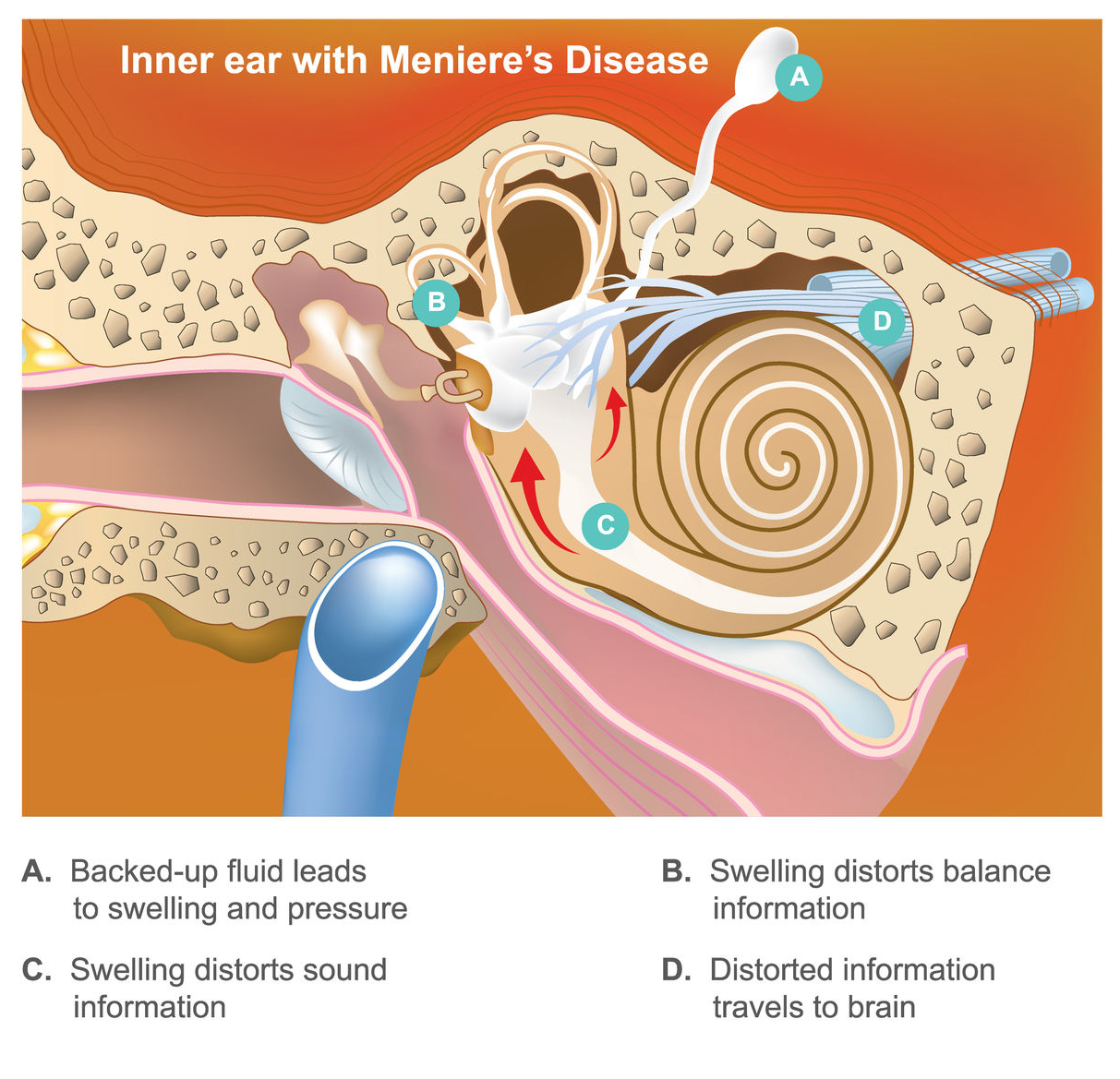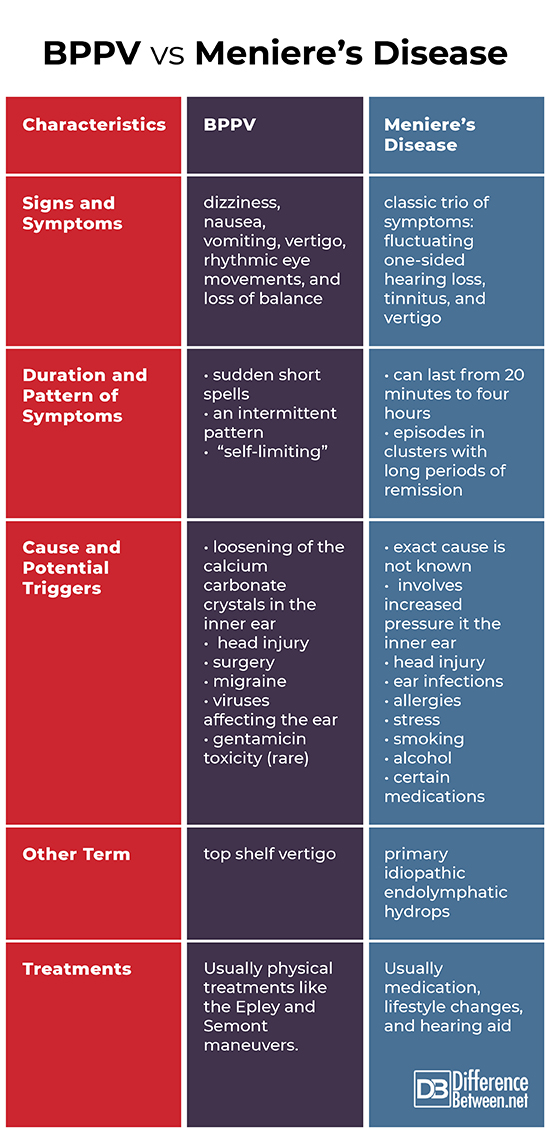Difference Between Benign Paroxysmal Positional Vertigo (BPPV) and Meniere’s Disease
BPPV and Meniere’s disease have very similar symptoms. For instance, BPPV is characterized by dizziness, nausea, vomiting, vertigo, rhythmic eye movements, and loss of balance. Similarly, the symptoms of Meniere’s disease include vertigo, spinning sensation, headaches, and loss of balance. Moreover, both of these conditions usually affect only one ear. However, BPPV is usually triggered by specific head movements while the attacks in Meniere’s disease can occur without warning. More of their differences are discussed below.

What is BPPV?
BPPV is characterized by dizziness, nausea, vomiting, vertigo, rhythmic eye movements, and loss of balance. In most patients, only one ear is affected. These symptoms are usually triggered by a change of the head’s position with respect to gravity. BPPV is sometimes called “top shelf vertigo” since the dizziness is often precipitated by looking up and other related motions like getting out of bed and quick head movements. Generally, the symptoms have an intermittent pattern; they may be experienced for around a couple of weeks, then stop, then recur. They are known as “self-limiting” since the symptoms usually subside or disappear within one to two months.
The cause is the loosening of the calcium carbonate crystals in the inner ear. This may be due to the degeneration of the inner ear’s vestibular system among the elderly, head injury (especially among people under age 50), surgery including dental work, migraine, viruses affecting the ear, and gentamicin toxicity (rare). The treatments include Epley maneuver (sequential movement of the head into four positions), Semont maneuver (brisk maneuver which is not presently favored in the U.S.), Foster maneuver (moving the head forward instead of backward as in Semont and Epley maneuvers), surgery, and home maneuvers like the Brandt-Daroff exercises, home Epley maneuver, and home Semont maneuver (Hain, 2019).

What is Meniere’s Disease?
Meniere’s disease is characterized by vertigo, spinning sensation, headaches, loss of balance, hearing problems, and a ringing sound. This condition involves the inner ear and often affects only one ear. It is also known as primary idiopathic endolymphatic hydrops (abnormal fluid in the inner ear). In 1861, Prosper Ménière, a French physician, proposed that the aforementioned symptoms originated from the inner ear rather than from the brain which was the popular belief during that time. The exact cause is not known; however, it is believed that it involves increased pressure in the inner ear. Its potential triggers include head injury, ear infections, allergies, stress, smoking, alcohol, stress, and certain medications.
This disease may be diagnosed through a hearing test and balance tests such as electronystagmography (ENG), rotary chair testing, and vestibular evoked myogenic potential (VEMP) tests. A cranial CT scan or a head MRI may also be ordered to rule out issues with the brain. The treatments include medication (e.g. motion sickness medicines, antiemetics, and/or diuretics), physical therapy (e.g. vestibular rehabilitation exercises), hearing aids, and surgery (e.g. endolymphatic sac procedure). Moreover, patients are encouraged to have lifestyle changes such as eating regularly, quitting smoking, limiting or excluding salt, MSG, caffeine, and alcohol from one’s diet, and effective stress management (Martel, 2018).
Difference between BPPV and Meniere’s Disease
Signs and Symptoms
BPPV is characterized by dizziness, nausea, vomiting, vertigo, rhythmic eye movements, and loss of balance. In comparison, Meniere’s disease is characterized by vertigo, spinning sensation, vomiting, headaches, loss of balance, hearing problems, a feeling of fullness in the affected ear, and a ringing sound. It also has a classic trio of symptoms: fluctuating one-sided hearing loss, tinnitus, and vertigo (Victory, 2020).
Duration and Pattern of Symptoms
Generally, the symptoms of BPPV come in sudden short spells (paroxysmal). They have an intermittent pattern; they may be experienced for around a couple of weeks, then stop, then recur. They are known as “self-limiting” since the symptoms usually subside or disappear within one to two months. On the other hand, the attacks in Meniere’s disease can last from 20 minutes to four hours. Those with this condition usually experience the episodes in clusters with long periods of remission (Victory, 2020).
Cause and Potential Triggers
Regarding BPPV, it is caused by the loosening of the calcium carbonate crystals in the inner ear. This may be due to the degeneration of the inner ear’s vestibular system (among the elderly), head injury (especially among people under age 50), surgery including dental work, migraine, viruses affecting the ear, and gentamicin toxicity (rare). It is also triggered by getting out of bed, quick head movements, and related motions. As for Meniere’s disease, the exact cause is not known; however, it is believed that it involves increased pressure in the inner ear. Its potential triggers include head injury, ear infections, allergies, stress, smoking, alcohol, and certain medications. However, the attacks can occur without warning.
Other Term
BPPV is sometimes called “top shelf vertigo” since the dizziness is often precipitated by looking up and other related motions like getting out of bed and quick head movements. Regarding Meniere’s disease, it is also known as primary idiopathic endolymphatic hydrops, which basically means having abnormal fluid in the inner ear.
Treatments
Most patients with BPPV get better after having physical treatments like the Epley and Semont maneuvers. Conversely, those with Meniere’s disease are usually treated with medication (e.g. motion sickness medicines, antiemetics, and/or diuretics), lifestyle changes (e.g. eating regularly, quit smoking, and limiting or excluding salt, MSG, and caffeine from diet) and hearing aids when appropriate.
BPPV vs Meniere’s Disease

Summary
- Unlike BPPV, Meniere’s disease has a classic trio of symptoms: fluctuating one-sided hearing loss, tinnitus, and vertigo.
- BPPV is due to the loosening of the calcium carbonate crystals in the inner ear while the exact cause of Meniere’s disease is not yet known.
- BPPV is sometimes called “top shelf vertigo” while Meniere’s disease is also known as primary idiopathic endolymphatic hydrops.
- Difference Between Hematoma and Melanoma - February 9, 2023
- Difference Between Bruising and Necrosis - February 8, 2023
- Difference Between Brain Hematoma and Brain Hemorrhage - February 8, 2023
Search DifferenceBetween.net :
Leave a Response
References :
[0]American Academy of Otaloryngology-Head and Neck Surgery. Patient Information Frequently Asked Questions: Benign Paroxysmal Positional Vertigo (BPPV), March 2017. https://bulletin.entnet.org/article/patient-informationfrequently-asked-questions-benign-paroxysmal-positional-vertigo-bppv/
[1]American Academy of Otaloryngology-Head and Neck Surgery. Patient Information Frequently Asked Questions: Benign Paroxysmal Positional Vertigo (BPPV), March 2017. https://bulletin.entnet.org/article/patient-informationfrequently-asked-questions-benign-paroxysmal-positional-vertigo-bppv/
[2]Hain, Timothy. Home Treatments of Benign Paroxysmal Positional Vertigo (BPPV). Chicago Dizziness and Hearing, January 30, 2019. https://www.dizziness-and-balance.com/disorders/bppv/home/home-pc.html
[3]Martel, Janelle. Meniere’s Disease. Healthline, September 28, 2018. https://www.healthline.com/health/menieres-disease
[4]Victory, Joy. Is There a Relationship between BPPV and Meniere’s Disease? Healthy Hearing, February 28, 2020. https://www.healthyhearing.com/report/31018-Relationship-between-bppv-and#:~:text=No.,disorders%20at%20the%20same%20time.
[5]Victory, Joy. Meniere’s Disease. Healthy Hearing, January 27, 2020. https://www.healthyhearing.com/help/tinnitus/menieres-disease#:~:text=Symptoms%20usually%20begin%20with%20the,with%20long%20periods%20of%20remission.
[6]Image credit: https://www.healthyhearing.com/uploads/images/menieres2.jpg
[7]Image credit: https://commons.wikimedia.org/wiki/File:BPPVvertigo_NL.png
